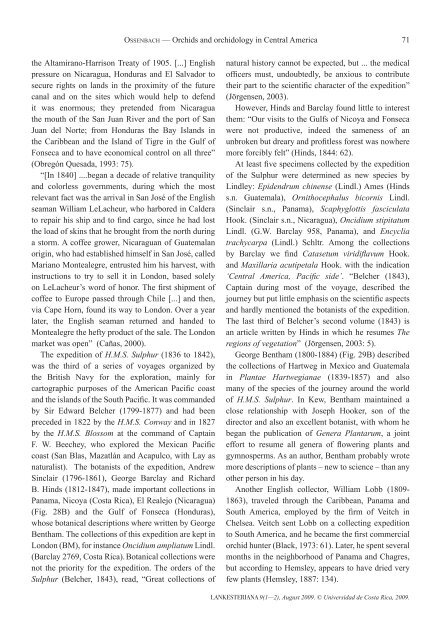orchids and orchidology in central america. 500 ... - lankesteriana.org
orchids and orchidology in central america. 500 ... - lankesteriana.org
orchids and orchidology in central america. 500 ... - lankesteriana.org
Create successful ePaper yourself
Turn your PDF publications into a flip-book with our unique Google optimized e-Paper software.
ossenbaCh — Orchids <strong>and</strong> <strong>orchidology</strong> <strong>in</strong> Central America<br />
the Altamirano-Harrison Treaty of 1905. [...] English<br />
pressure on Nicaragua, Honduras <strong>and</strong> El Salvador to<br />
secure rights on l<strong>and</strong>s <strong>in</strong> the proximity of the future<br />
canal <strong>and</strong> on the sites which would help to defend<br />
it was enormous; they pretended from Nicaragua<br />
the mouth of the San Juan River <strong>and</strong> the port of San<br />
Juan del Norte; from Honduras the Bay Isl<strong>and</strong>s <strong>in</strong><br />
the Caribbean <strong>and</strong> the Isl<strong>and</strong> of Tigre <strong>in</strong> the Gulf of<br />
Fonseca <strong>and</strong> to have economical control on all three”<br />
(Obregón Quesada, 1993: 75).<br />
“[In 1840] ....began a decade of relative tranquility<br />
<strong>and</strong> colorless governments, dur<strong>in</strong>g which the most<br />
relevant fact was the arrival <strong>in</strong> San José of the English<br />
seaman William LeLacheur, who harbored <strong>in</strong> Caldera<br />
to repair his ship <strong>and</strong> to f<strong>in</strong>d cargo, s<strong>in</strong>ce he had lost<br />
the load of sk<strong>in</strong>s that he brought from the north dur<strong>in</strong>g<br />
a storm. A coffee grower, Nicaraguan of Guatemalan<br />
orig<strong>in</strong>, who had established himself <strong>in</strong> San José, called<br />
Mariano Montealegre, entrusted him his harvest, with<br />
<strong>in</strong>structions to try to sell it <strong>in</strong> London, based solely<br />
on LeLacheur’s word of honor. The first shipment of<br />
coffee to Europe passed through Chile [...] <strong>and</strong> then,<br />
via Cape Horn, found its way to London. Over a year<br />
later, the English seaman returned <strong>and</strong> h<strong>and</strong>ed to<br />
Montealegre the hefty product of the sale. The London<br />
market was open” (Cañas, 2000).<br />
The expedition of H.M.S. Sulphur (1836 to 1842),<br />
was the third of a series of voyages <strong>org</strong>anized by<br />
the British Navy for the exploration, ma<strong>in</strong>ly for<br />
cartographic purposes of the American Pacific coast<br />
<strong>and</strong> the isl<strong>and</strong>s of the South Pacific. It was comm<strong>and</strong>ed<br />
by Sir Edward Belcher (1799-1877) <strong>and</strong> had been<br />
preceded <strong>in</strong> 1822 by the H.M.S. Conway <strong>and</strong> <strong>in</strong> 1827<br />
by the H.M.S. Blossom at the comm<strong>and</strong> of Capta<strong>in</strong><br />
F. W. Beechey, who explored the Mexican Pacific<br />
coast (San Blas, Mazatlán <strong>and</strong> Acapulco, with Lay as<br />
naturalist). The botanists of the expedition, Andrew<br />
S<strong>in</strong>clair (1796-1861), Ge<strong>org</strong>e Barclay <strong>and</strong> Richard<br />
B. H<strong>in</strong>ds (1812-1847), made important collections <strong>in</strong><br />
Panama, Nicoya (Costa Rica), El Realejo (Nicaragua)<br />
(Fig. 28B) <strong>and</strong> the Gulf of Fonseca (Honduras),<br />
whose botanical descriptions where written by Ge<strong>org</strong>e<br />
Bentham. The collections of this expedition are kept <strong>in</strong><br />
London (BM), for <strong>in</strong>stance Oncidium ampliatum L<strong>in</strong>dl.<br />
(Barclay 2769, Costa Rica). Botanical collections were<br />
not the priority for the expedition. The orders of the<br />
Sulphur (Belcher, 1843), read, “Great collections of<br />
natural history cannot be expected, but ... the medical<br />
officers must, undoubtedly, be anxious to contribute<br />
their part to the scientific character of the expedition”<br />
(Jörgensen, 2003).<br />
However, H<strong>in</strong>ds <strong>and</strong> Barclay found little to <strong>in</strong>terest<br />
them: “Our visits to the Gulfs of Nicoya <strong>and</strong> Fonseca<br />
were not productive, <strong>in</strong>deed the sameness of an<br />
unbroken but dreary <strong>and</strong> profitless forest was nowhere<br />
more forcibly felt” (H<strong>in</strong>ds, 1844: 62).<br />
At least five specimens collected by the expedition<br />
of the Sulphur were determ<strong>in</strong>ed as new species by<br />
L<strong>in</strong>dley: Epidendrum ch<strong>in</strong>ense (L<strong>in</strong>dl.) Ames (H<strong>in</strong>ds<br />
s.n. Guatemala), Ornithocephalus bicornis L<strong>in</strong>dl.<br />
(S<strong>in</strong>clair s.n., Panama), Scaphyglottis fasciculata<br />
Hook. (S<strong>in</strong>clair s.n., Nicaragua), Oncidium stipitatum<br />
L<strong>in</strong>dl. (G.W. Barclay 958, Panama), <strong>and</strong> Encyclia<br />
trachycarpa (L<strong>in</strong>dl.) Schltr. Among the collections<br />
by Barclay we f<strong>in</strong>d Catasetum viridiflavum Hook.<br />
<strong>and</strong> Maxillaria acutipetala Hook. with the <strong>in</strong>dication<br />
‘Central America, Pacific side’. “Belcher (1843),<br />
Capta<strong>in</strong> dur<strong>in</strong>g most of the voyage, described the<br />
journey but put little emphasis on the scientific aspects<br />
<strong>and</strong> hardly mentioned the botanists of the expedition.<br />
The last third of Belcher’s second volume (1843) is<br />
an article written by H<strong>in</strong>ds <strong>in</strong> which he resumes The<br />
regions of vegetation” (Jörgensen, 2003: 5).<br />
Ge<strong>org</strong>e Bentham (1800-1884) (Fig. 29B) described<br />
the collections of Hartweg <strong>in</strong> Mexico <strong>and</strong> Guatemala<br />
<strong>in</strong> Plantae Hartwegianae (1839-1857) <strong>and</strong> also<br />
many of the species of the journey around the world<br />
of H.M.S. Sulphur. In Kew, Bentham ma<strong>in</strong>ta<strong>in</strong>ed a<br />
close relationship with Joseph Hooker, son of the<br />
director <strong>and</strong> also an excellent botanist, with whom he<br />
began the publication of Genera Plantarum, a jo<strong>in</strong>t<br />
effort to resume all genera of flower<strong>in</strong>g plants <strong>and</strong><br />
gymnosperms. As an author, Bentham probably wrote<br />
more descriptions of plants – new to science – than any<br />
other person <strong>in</strong> his day.<br />
Another English collector, William Lobb (1809-<br />
1863), traveled through the Caribbean, Panama <strong>and</strong><br />
South America, employed by the firm of Veitch <strong>in</strong><br />
Chelsea. Veitch sent Lobb on a collect<strong>in</strong>g expedition<br />
to South America, <strong>and</strong> he became the first commercial<br />
orchid hunter (Black, 1973: 61). Later, he spent several<br />
months <strong>in</strong> the neighborhood of Panama <strong>and</strong> Chagres,<br />
but accord<strong>in</strong>g to Hemsley, appears to have dried very<br />
few plants (Hemsley, 1887: 134).<br />
LANKESTERIANA 9(1—2), August 2009. © Universidad de Costa Rica, 2009.<br />
71
















